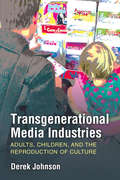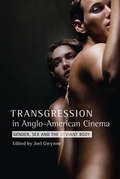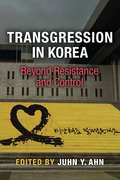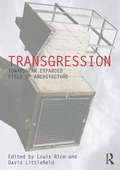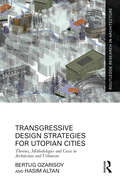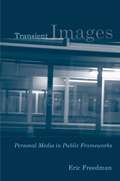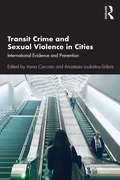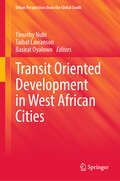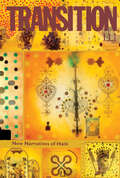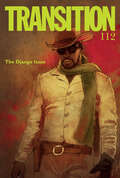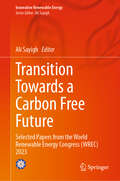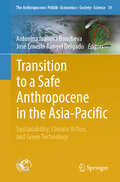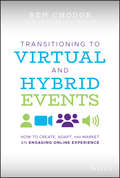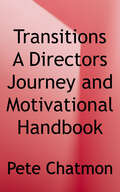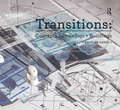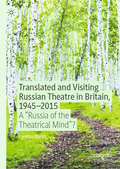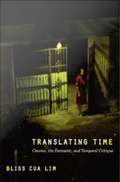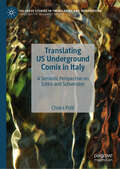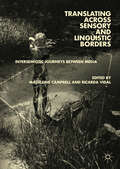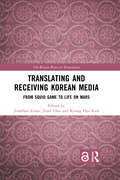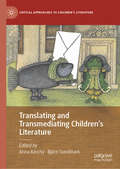- Table View
- List View
Transgenerational Media Industries: Adults, Children, and the Reproduction of Culture
by Derek JohnsonWithin corporate media industries, adults produce children’s entertainment. Yet children, presumed to exist outside the professional adult world, make their own contributions to it—creating and posting unboxing videos, for example, that provide content for toy marketers. Many adults, meanwhile, avidly consume entertainment products nominally meant for children. Media industries reincorporate this market-disrupting participation into their strategies, even turning to adult consumers to pass fandom to the next generation. Derek Johnson presents an innovative perspective that looks beyond the simple category of “kids’ media” to consider how entertainment industry strategies invite producers and consumers alike to cross boundaries between adulthood and childhood, professional and amateur, new media and old. Revealing the social norms, reproductive ideals, and labor hierarchies on which such transformations depend, he identifies the lines of authority and power around which legacy media institutions like television, comics, and toys imagine their futures in a digital age. Johnson proposes that it is not strategies of media production, but of media reproduction, that are most essential in this context. To understand these critical intersections, he investigates transgenerational industry practice in television co-viewing, recruitment of adult comic readers as youth outreach ambassadors, media professionals’ identification with childhood, the branded management of adult fans of LEGO, and the labor of child YouTube video creators. These dynamic relationships may appear to disrupt generational and industry boundaries alike. However, by considering who media industries empower when generating the future in these reproductive terms and who they leave out, Johnson ultimately demonstrates how their strategies reinforce existing power structures. This book makes vital contributions to media studies in its fresh approach to the intersections of adulthood and childhood, its attention to the relationship between legacy and digital media industries, and its advancement of dialogue between media production and consumption researchers. It will interest scholars in media industry studies and across media studies more broadly, with particular appeal to those concerned about the current and future reach of media industries into our lives.
Transgression in Anglo-American Cinema: Gender, Sex, and the Deviant Body
by Joel GwynneSexuality within mainstream Hollywood cinema features primarily in comedy or rom-com genres, where lightness of tone permits audience engagement with what would otherwise be difficult affective terrain. Focusing on marginal productions in Anglo-American contexts, this collection explores the gendered dynamics of sex and the body, particularly embodied deviations from normative cultural scripts. It explores transgressions acted through and written on the body, and the ways in which corporeality inscribes gender discourse and reflects cultural and institutional power. Films analyzed include Mysterious Skin (2004), Shame (2011), Nymphomaniac (2013), and Dallas Buyers Club (2013). Navigating queer politics, taboo fantasy, body modification, fetishism, sex addiction, and underage sex, essays problematize understandings of adult agency, childhood innocence, and healthy desire, locating sex and gender as sites of oppression, liberation, and resistance.
Transgression in Korea: Beyond Resistance and Control (Perspectives On Contemporary Korea)
by Juhn Young AhnSince the turn of the millennium South Korea has continued to grapple with transgressions that shook the nation to its core. Following the serial killings of Korea’s raincoat killer, the events that led to the dissolution of the United Progressive Party, the criminal negligence of the owner and also the crew members of the sunken Sewol Ferry, as well as the political scandals of 2016, there has been much public debate about morality, transparency, and the law in South Korea. Yet, despite its prevalence in public discourse, transgression in Korea has not received proper scholarly attention. Transgression in Korea challenges the popular conceptions of transgression as resistance to authority, the collapse of morality, and an attempt at self- empowerment. Examples of transgression from premodern, modern, and contemporary Korea are examined side by side to underscore the possibility of reading transgression in more ways than one. These examples are taken from a devotional screen from medieval Korea, trickster tales from the late Choson period, reports about flesheating humans, newspaper articles about same- sex relationships from colonial Korea, and films about extramarital affairs, wayward youths, and a vengeful vigilante. Bringing together specialists from various disciplines such as history, art history, anthropology, premodern literature, religion, and fi lm studies, the context- sensitive readings of transgression provided in this book suggest that transgression and authority can be seen as forming something other than an antagonistic relationship.
Transgression: Towards an expanded field of architecture
by Louis Rice David LittlefieldTransgression means to 'cross over': borders, disciplines, practices, professions, and legislation. This book explores how the transgression of boundaries produces new forms of architecture, education, built environments, and praxis. Based on material from the 10th International Conference of the AHRA, this volume presents contributions from academics, practicing architects and artists/activists from around the world to provide perspectives on emerging and transgressive architecture. Divided into four key themes – boundaries, violations, place and art practice - it explores global processes, transformative praxis and emerging trends in architectural production, examining alternative and radical ways of practicing architecture and reimagining the profession. The wide range of international contributors are drawn from subject areas such as architecture, cultural geography, urban studies, sociology, fine art, film-making, photography, and environmentalism, and feature examples from regions such as the United States, Europe and Asia. At the forefront of exploring inter-disciplinary and trans-disciplinary research and practice, Transgression will be key reading for students, researchers and professionals with an interest in the changing nature of architectural and spatial disciplines.
Transgressive Design Strategies for Utopian Cities: Theories, Methodologies and Cases in Architecture and Urbanism (Routledge Research in Architecture)
by Bertug Ozarisoy Hasim AltanThis book critically examines the philosophy of the term ‘transgression’ and how it shapes the utopian vision of contemporary urban design scenarios. The aim of this book is to provide scholarly yet accessible graphic novel illustrations to inform narratives of urban manifestos. Through four select case studies from the UK, Cyprus and Germany, the book highlights the paradoxes and contradictions in architecture and provides detailed evaluation of the limits and contemporary forms of sustainable urban regeneration. The book proposes an ‘utopian urban vision’ approach to social, political and cultural relations, trends and tensions – both locally and globally – and seeks to inspire an awakening in architectural discourse. The book argues that the philosophical undermining of transgression is the result of a phenomenon from a different perspective – its philosophical background, social construction, experimental research process and design implications on the city. As such, the book provides a critical examination of how architectural design interventions contribute to sustainable urban regeneration and gentrification and can impact local communities. This book provides a significant contribution to both undergraduate and postgraduate students, as well as early career researchers working in architecture, planning and sustainable urban design. It offers effective guidance on adopting the state-of-the-art graphical illustrations into their own design projects, while considering contradictions between architectural discourse and the philosophy of transgression.
Transient Images: Personal Media in Public Frameworks
by Eric FreedmanIn this probing study, Eric Freedman focuses on what images from photography, mobile communications, and the Internet reveal about looking. Exploring subjectivity by critically examining the look, he elaborates on the nature of the photographic frame and its relation to interpretive practices. Freedman scrutinizes what he calls "technobiography"—a life written through technology, and considers the movement of personal images into public spaces. He also considers authorship that situates the self as inherently engaged with and inscribed by information technology. All of the chapters in Transient Images explore Freedman's interest in examining how media technologies activate particular notions of self and community. He provides examples that address trauma—pictures of missing children on milk cartons and episodes of the reality series Intervention—as well as the strategies behind creating and distributing personal advertisements on the Internet. Transient Images draws out the tensions that exist in images circulating in the digital era.
Transit Crime and Sexual Violence in Cities: International Evidence and Prevention
by Vania CeccatoHow cities are planned and designed has a major impact on individuals’ mobility and safety. If individuals feel unsafe in public transportation or on the way to it, they may avoid certain routes or particular times of the day. This is problematic, since research has also found that, in some cities, especially those in the Global South, a large percentage of women are "transit captives". Namely, they have relatively less access to non-public forms of transportation and are, therefore, especially reliant on public transport. This issue is important not only because it affects people’s safety but also because it influences the long-term sustainability of a city. In a sustainable city, safety guarantees the ability to move freely for everyone and provides a wider sense of place attachment. Transit Crime and Sexual Violence in Cities examines the evidence of victimization in transit environments in countries around the world, exploring individuals’ feelings of perceived safety or lack thereof and the necessary improvements that can make transit safer and, hence, cities more sustainable. The book’s contributions are grounded in theories at the crossroads of several disciplines such as environmental criminology, architecture and design, urban planning, geography, psychology, gender and LGBTQI studies, transportation, and law enforcement. International case studies include Los Angeles, Vancouver, Stockholm, London, Paris, São Paulo, Mexico City, Bogotá, Tokyo, Guangzho, Melbourne, and Lagos, among others.
Transit Oriented Development in West African Cities (GeoJournal Library)
by Taibat Lawanson Basirat Oyalowo Timothy NubiThe book addresses conceptual issues around urban transportation policy and practice in selected west African cities. It highlights the institutional, socio economic and infrastructural barriers of transit-oriented development in West Africa. Through a series of case studies, the chapters present how transport governance systems affect housing, land, infrastructure development, urbanization dynamics, construction and the urban poor.The chapters in this book are written by authors from multi-disciplinary backgrounds including architecture, construction management, real estate, urban planning and public health, and are members of the African Research Network on Urbanization and Habitable Cities, a research network supported by the UKRI African Research Universities Alliance Capacity Building Programme. By providing a solid empirical portrait based on lived and research experience, this book will be a great resource to students, academics and policy makers in transport, urbanplanning and development policy as well as social scientists.
Transit Street Design Guide
by National Association of City Transportation OfficialsThe Transit Street Design Guide is a well-illustrated, detailed introduction to designing streets for high-quality transit, from local buses to BRT, from streetcars to light rail. Drawing on the expertise of a peer network and case studies from across North America, the guide provides a much-needed link between transit planning, transportation engineering, and street design. The Transit Street Design Guide presents a new set of core principles, street typologies, and design strategies that shift the paradigm for streets, from merely accommodating service to actively prioritizing great transit.The Transit Street Design Guide is a vital resource for every transportation planner, transit operations planner, and city traffic engineer working on making streets that move more people more efficiently and affordably.
Transit Tourism: The Iconic Art and Design of 22 Subway Systems Around the World
by David SeltzerIn Transit Tourism: The Iconic Art and Design of 22 Subway Systems around the World, readers embark on a visual journey through the world's bustling subway systems, where each station tells a story of its city's soul. From the ornate elegance of Moscow's stations to the sleek minimalism of Tokyo's, this illustrated collection of travel essays explores 22 urban metros, revealing how their architecture, art, and design reflect the unique character and culture of each metropolis. Whether urban explorers, design aficionados, or simply curious about the hidden narratives beneath our cities, readers will encounter a fresh perspective on the subterranean worlds that shape our urban landscapes.Key Features:Visual culture showcase: Explore architecture, art installations, and graphic design.Unique book design: Each chapter mimics a subway line, with color-coded sections and Museo typeface inspired by timetable brochures.Entertaining narrative: Travel essays written from a tour guide&’s viewpoint for a passenger's perspective, blending humor and observation.Global scope: Covers major systems in North America, Europe, and Asia, appealing to travelers and urban enthusiasts alike.Subway system ratings: Each chapter concludes with a unique token ranking system, evaluating subway systems on convenience, design quality, and personality, providing readers with an assessment for planning their transit adventures. Uncover the fascinating stories beneath your feet with Transit Tourism: The Iconic Art and Design of 22 Subway Systems around the World, a captivating exploration of how subways shape and define the cities we love.
Transition 111: New Narratives of Haiti (Transition #111)
by IU Press JournalsThe 111th issue of the magazine of Africa and the Diaspora, featuring fiction, poetry, art, and essays focused on the black world.Published three times per year by Indiana University Press for the Hutchins Center at Harvard University, Transition is a unique forum for the freshest, most compelling ideas from and about the black world. Since its founding in Uganda in 1961, the magazine has kept apace of the rapid transformation of the African Diaspora and has remained a leading forum of intellectual debate.In issue 111, Transition focuses on “New Narratives of Haiti.” Guest editors Laurent Dubois and Kaiama L. Glover have invited contributors to think about the world in ways that place Haiti at its center. Thought pieces by Madison Smartt Bell, Jonathan Katz, Gina Athena Ulysse and others, as well as translations of Franketienne, Lyonel Trouillot, and Michel-Rolph Trouillot, dispel trenchant cliches that have long plagued representations of Haiti in literature and scholarship. This issue also includes Jamaica Kincaid’s poignant memories of a brother lost to AIDS, and a scholar’s chance discovery of cultural (and genealogical?) links between Cuba and Sierra Leone. Exceptional poetry, fiction, and review essays also take us beyond Haiti to San Francisco, Rio de Janeiro, Nairobi, and Renaissance Europe.
Transition 112: The Django Issue (Transition #112)
by IU Press JournalsIssue #112 looks at violence and its relation to the history of slavery, featuring pieces on the films Django Unchained and Lincoln.Published three times per year by Indiana University Press for the Hutchins Center at Harvard University, Transition is a unique forum for the freshest, most compelling ideas from and about the black world. Since its founding in Uganda in 1961, the magazine has kept apace of the rapid transformation of the African Diaspora and has remained a leading forum of intellectual debate.In issue 112, the editors of Transition look at violence, particularly as it relates to the history of slavery, which raises the question of representation. Textbooks and television both grapple with the same fundamental questions: to whom do the stories of slaves belong? How should these stories be told? In this issue, Daniel Itzkovitz talks with Tony Kushner about the controversy that surrounded the making of Lincoln, a serious and sober film about the passage of the 13th Amendment. Django Unchained covers the same time period but uses a wildly different lens. The film is terrifying and topsy-turvy, and has ignited controversy that became a white-hot conflagration. Henry Louis Gates, Jr. speaks with Quentin Tarantino about the making of his film, and a host of scholars and critics, including Walter Johnson, Glenda Carpio, and Terri Francis, set the issue ablaze with provocative and searing commentary that speaks to the controversial film and its potent afterlife.
Transition Towards a Carbon Free Future: Selected Papers from the World Renewable Energy Congress (WREC) 2023 (Innovative Renewable Energy)
by Ali SayighThis book contains selected papers from the 22nd World Renewable Energy Congress (WREC 2023) in Kuala Lumpur. The forum promotes renewable energy global development and features top international experts, policymakers, scientists, engineers, technology developers, and business practitioners addressing the most current research in sustainable energy development and innovation. The contributions address policy, technology, and applications across a wide range of topics, including solar thermal, geothermal energy, wind energy, turbines and generators, bioclimatic architecture, energy audits, construction and design, low carbon mobility, green steel, batteries and supercapacitors, regulatory issues and public policy, circular economy, urban mining and much more.
Transition to a Safe Anthropocene in the Asia-Pacific: Sustainability, Climate Action, and Green Technology (The Anthropocene: Politik—Economics—Society—Science #39)
by José Ernesto Rangel Delgado Antonina Ivanova BonchevaThe Anthropocene concept highlights that we are now living in a new epoch of earth history where both the rapid accumulation of greenhouse gases and excessive consumption of natural resources endanger human and planetary wellbeing. Climate change is one of the main drivers of the Anthropocene and is intricately linked to many great challenges we face: lack of fresh water, food security, biodiversity loss, and human rights of present and future generations. The radical influence of humanity on nature must change from destructive to reconstructive, by the path of sustainable development, circular economy, climate action, green technology, and environmental awareness. This book explores the pathways of transition towards a safe and sustainable Anthropocene in the Asia-Pacific and reviews the progress and the challenges in climate action, the recovery from COVID-19, and the re-articulation of world order. The chapters address both regional and country levels, the majority analysing China and Mexico. The experiences presented can be replicated in other regions of the world. The book offers useful insights for all interested in the Anthropocene, in climate action, sustainability, and the relationship between human beings and nature, thus motivating the decision-makers to implement a just and inclusive transition to a safe Anthropocene. • A novel study that explores links between the Anthropocene, climate change, and sustainability, framing the transition towards a safe and sustainable Anthropocene in the Asia-Pacific. • Strategies and policies on climate action, renewable energies, green technology, and environmental education include the participation of governments, NGOs, and civil society. • Case studies based on experiences at the regional and country level provide valuable insights for both industrialised and developing countries.
Transitioning to Virtual and Hybrid Events: How to Create, Adapt, and Market an Engaging Online Experience
by Ben ChodorCreating virtual events is not as simple as moving the same content online — learn how to immediately leverage virtual solutions for effective in-person online events As the global COVID-19 pandemic continues to have unprecedented impact on both the global economy and the whole of the world population, the need for effectively and efficiently connecting people and the right information has never been more urgent. Although the technology infrastructure currently exists, many organizations are scrambling to create virtual meetings and events to address important time-sensitive issues. Transitioning to Virtual and Hybrid Events explains everything an event host needs to know about going virtual, from understanding the new audience, to adapting content to the new medium, to marketing effectively, and much more. Author Ben Chodor, president of Intrado Digital Media, provides expert advice and real-world instructions for delivering engaging hybrid, virtual, and streaming events and webinars for companies of all sizes and across all industries. Packed with detailed tutorials, real-world case studies, illustrative examples, and highly useful checklists, this comprehensive resource provides step-by-step guidance on: Planning, creating, and implementing a digital event Choosing between a stream, a webcast, or a hybrid event Evaluating different technological solutions Producing compelling virtual content for a variety of scenarios Effectively promoting online events Meeting the needs of a diverse and global audience Transitioning to Virtual and Hybrid Events is an indispensable instruction manual for anyone tasked with enhancing their organization’s continuity plans, enabling their employee base to work remotely, or creating any type of virtual solution to meet this urgent crisis.
Transitions: A Director's Journey and Motivational Handbook
by Pete ChatmonBecoming a director is not just about making a film, webseries, commercial, or music video. The opportunity to direct for television is not a given because you've successfully completed a project in another medium. Turning your passion into your profession requires the ability to make transitions at the exact moment a pivot is needed, with creativity and confidence. Chatmon's book helps directors across all mediums shape their career with targeted anecdotes, worksheets, and other resources, all of which fall into three designated categories: How-To, Self-Help, and Inspiration.
Transitions: Concepts + Drawings + Buildings (Design Research in Architecture)
by Christine HawleyMost architectural books written by practising architects fall into two categories: theoretical texts, or monographs that describe and illustrate the author's projects. This book combines both, as it explores and illustrates the methodological journey required to translate a concept to a drawing and a drawing to a building. While the term 'methodological' might imply an Aristotelian logic, there is no attempt here to rationalise the process of conception, but instead an acknowledgement of an experimental approach that presupposes a subtle knowledge of the projects. It shows the architect's fascination with the 'opaque' and the 'not said' and illustrates how architecture works through agreement and contradiction (e.g. the built and the un-built, material and immaterial). Organised into three essays Urban Collage, Ground Surface, Shadows and Lines, the book examines how conceptual threads begin to compose a specific architectural design 'language' and how they interweave from one direction to another. Importantly, the projects that illustrate the text also demonstrate how imperative or marginal the original ideas become and, to an extent they demonstrate the design process: its successes, illogicality and failures. The essays also discuss the importance of iteration through time where ideas may occasionally be developed as a linear process, but more often emerge through a series of creative digressions. Although the essays and the projects have dominant themes, these should not be regarded as autonomous, as throughout the development of both drawings and buildings, ideas inevitably segue from one domain to another. Ideas have both fluidity and the ability to transform.
Translated and Visiting Russian Theatre in Britain, 1945–2015: A "Russia of the Theatrical Mind"?
by Cynthia MarshThis book tackles questions about the reception and production of translated and untranslated Russian theatre in post-WW2 Britain: why in British minds is Russia viewed almost as a run-of-the-mill production of a Chekhov play. Is it because Chekhov is so dominant in British theatre culture? What about all those other Russian writers? Many of them are very different from Chekhov. A key question was formulated, thanks to a review by Susannah Clapp of Turgenev’s A Month in the Country: have the British staged a ‘Russia of the theatrical mind’?
Translating Film Subtitles into Chinese: A Multimodal Study
by Yuping ChenThis book examines three metafunction meanings in subtitle translation with three research foci, i.e., the main types of cross-modal interrelation, the primary function of semiotic interplay, and the key linguistic components influencing the subtitles. It goes beyond traditional textual analysis in translation studies; approaches subtitle translation from a multimodality standpoint; and breaks through the linguistic restraints on subtitling research by underscoring the role of semiotic interplay. In the field of multimodality, this book bridges subtitling and multimodality by investigating the interweaving relationships between different semiotic modes, and their corresponding impacts on subtitle translation.
Translating Samuel Beckett around the World (New Interpretations of Beckett in the Twenty-First Century)
by José Francisco Fernández Pascale SardinThe global reception of Samuel Beckett raises numerous questions: in which areas of the world was Beckett first translated? Why were Beckett texts sometimes slow to penetrate certain cultures? How were national literatures impacted by Beckett's oeuvre? Translating Samuel Beckett around the World brings together leading researchers in Beckett studies to discuss these questions and explore the fate of Beckett in their own societies and national languages. The current text provides ample coverage of the presence of Beckett in geographical contexts normally ignored by literary criticism, and reveals unknown aspects of the 1969 Nobel Prize winner interacting with translators of his work in a number of different countries.
Translating Time: Cinema, the Fantastic, and Temporal Critique
by Bliss Cua LimUnder modernity, time is regarded as linear and measurable by clocks and calendars. Despite the historicity of clock-time itself, the modern concept of time is considered universal and culturally neutral. What Walter Benjamin called "homogeneous, empty time" founds the modern notions of progress and a uniform global present in which the past and other forms of time consciousness are seen as superseded. In Translating Time, Bliss Cua Lim argues that fantastic cinema depicts the coexistence of other modes of being alongside and within the modern present, disclosing multiple "immiscible temporalities" that strain against the modern concept of homogeneous time. In this wide-ranging study--encompassing Asian American video (On Cannibalism), ghost films from the New Cinema movements of Hong Kong and the Philippines (Rouge, Itim, Haplos), Hollywood remakes of Asian horror films (Ju-on, The Grudge, A Tale of Two Sisters) and a Filipino horror film cycle on monstrous viscera suckers (Aswang)--Lim conceptualizes the fantastic as a form of temporal translation. The fantastic translates supernatural agency in secular terms while also exposing an untranslatable remainder, thereby undermining the fantasy of a singular national time and emphasizing shifting temporalities of transnational reception. Lim interweaves scholarship on visuality with postcolonial historiography. She draws on Henri Bergson's understanding of cinema as both implicated in homogeneous time and central to its critique, as well as on postcolonial thought linking the ideology of progress to imperialist expansion. At stake in this project are more ethical forms of understanding time that refuse to domesticate difference as anachronism. While supernaturalism is often disparaged as a vestige of primitive or superstitious thought, Lim suggests an alternative interpretation of the fantastic as a mode of resistance to the ascendancy of homogeneous time and a starting-point for more ethical temporal imaginings.
Translating US Underground Comix in Italy: A Semiotic Perspective on Satire and Subversion (Palgrave Studies in Translating and Interpreting)
by Chiara PolliThis book analyses 1960s-1970s US underground comix, a &‘counterculture&’ art form that satirised mainstream values and taboos. The author observes comix in their multimodal components in the original English-language versions and in their Italian translations by unpacking the several layers of verbal and visual meaning-making. She then goes on to scrutinise translation and resemiotisation processes, including modifications, mitigations, and omissions, encompassing socio-historical and cross-cultural perspectives. The book argues that translation, meant to bridge two (counter-)cultures, served as a gatekeeper instead, zooming in on certain themes, while inadvertently overlooking or purposefully manipulating others, with an outcome close to censorship. The volume is divided into nine chapters. Chapter 1 summarises the aims and scope of the volume. Chapter 2 introduces comix as a subversive phenomenon. Chapter 3 illustrates the theoretical and methodological framework of analysis, based on semiotics and multimodality. Chapter 4 presents the corpus of Italian translations, which includes works translated between 1968 and 2022 by both mainstream and alternative publishers. In Chapters 5-8, Italian translations of comix dealing with such controversial themes as sex, drugs, political struggle, and religion are analysed, with qualitative observations of several translations of the same comix provided to highlight changing times, cultural frames, ideologies, editorial policies, and target audiences. Chapter 9 discusses the findings of these observations and maintains that, as a recursive translation strategy, seditious contents were mitigated, trivialised, or censored by adopting light-hearted frames so that potentially problematic contents could be left out. With its linguistic, translational, and intercultural analyses, this volume will be useful for researchers of linguistics, semiotics, translation, and comics studies.
Translating across Sensory and Linguistic Borders: Intersemiotic Journeys between Media
by Ricarda Vidal Madeleine CampbellThis book analyses intersemiotic translation, where the translator works across sign systems and cultural boundaries. Challenging Roman Jakobson’s seminal definitions, it examines how a poem may be expressed as dance, a short story as an olfactory experience, or a film as a painting. This emergent process opens up a myriad of synaesthetic possibilities for both translator and target audience to experience form and sense beyond the limitations of words. The editors draw together theoretical and creative contributions from translators, artists, performers, academics and curators who have explored intersemiotic translation in their practice. The contributions offer a practitioner’s perspective on this rapidly evolving, interdisciplinary field which spans semiotics, cognitive poetics, psychoanalysis and transformative learning theory. The book underlines the intermedial and multimodal nature of perception and expression, where semiotic boundaries are considered fluid and heuristic rather than ontological. It will be of particular interest to practitioners, scholars and students of modern foreign languages, linguistics, literary and cultural studies, interdisciplinary humanities, visual arts, theatre and the performing arts.
Translating and Receiving Korean Media: From Squid Game to Life on Mars (The Korean Wave in Translation)
by Jonathan Evans Kyung Hye Kim Jinsil ChoiIn recent years, Korean culture has been incredibly successful internationally, from the films of auteur directors like Bong Joon-ho (Parasite) to shows like Squid Game and K-pop music. At the same time, media from the UK has also been successful in South Korea, with popular shows such as Killing Eve and Life on Mars. Written by scholars working across translation, film and media studies, this volume examines the ways in which Korean media has been received and translated in the UK, as well as how British media has fared in South Korea. Case studies explore how Korean media is (re)packaged and categorised for a Western audience and how paratextual material (trailers, adverts, fan reactions) mediates films and shows for international audiences. The book also examines how the Korean remake of Life on Mars localises the British show, how Squid Game has been audio-described and how slower media models can suggest more sustainable forms of consumption and distribution. Demonstrating how interdisciplinary research can shed light on different aspects of global media culture, this volume will be essential reading for scholars and students working on the translation and international media circulation. It will especially appeal to readers interested in the interactions between British and Korean media.This work was supported by the Fund for International Collaboration and the Economic and Social Research Council [grant number ES/W01081X/1].
Translating and Transmediating Children’s Literature (Critical Approaches to Children's Literature)
by Björn Sundmark Anna KérchyFrom Struwwelpeter to Peter Rabbit, from Alice to Bilbo—this collection of essays shows how the classics of children’s literature have been transformed across languages, genres, and diverse media forms. This book argues that translation regularly involves transmediation—the telling of a story across media and vice versa—and that transmediation is a specific form of translation. Beyond the classic examples, the book also takes the reader on a worldwide tour, and examines, among other things, the role of Soviet science fiction in North Korea, the ethical uses of Lego Star Wars in a Brazilian context, and the history of Latin translation in children’s literature. Bringing together scholars from more than a dozen countries and language backgrounds, these cross-disciplinary essays focus on regularly overlooked transmediation practices and terminology, such as book cover art, trans-sensory storytelling, écart, enfreakment, foreignizing domestication, and intra-cultural transformation.
